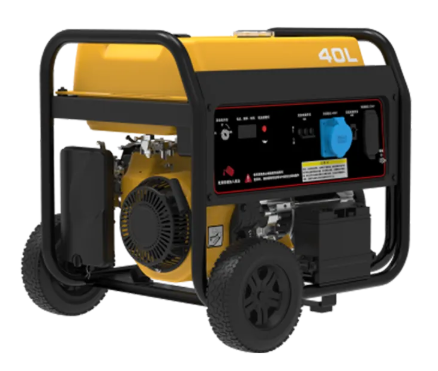آیا میدانستید که تأسیسات صنعتی ممکن است تا ۳۰ درصد از هزینههای انرژی خود را به دلیل تولید ناکارآمد برق هدر دهند؟ در دورانی که بازدهی انرژی مستقیماً بر سودآوری و پایداری تأثیر میگذارد، بهینهسازی ژنراتور دیزل عملکرد دیگر اختیاری نیست— بلکه برای حفظ مزیت رقابتی ضروری است. برای مدیران کارخانه، مهندسان تأسیسات و مدیران عملیات، حداکثر کردن بازدهی به معنای کاهش مصرف سوخت، کاهش انتشارات، افزایش عمر تجهیزات و در نهایت حفاظت از سود نهایی است. این راهنمای جامع استراتژیهای اثباتشده و فناوریهای پیشرفتهای را آشکار میکند که میتوانند ژنراتور دیزل را از یک هزینه ضروری به داراییای کارآمد تبدیل کنند که برتری عملیاتی را هدایت میکند.
درک معیارهای بازدهی ژنراتور دیزلی
شاخصهای عملکرد کلیدی
برای حداکثر کردن بازدهی، ابتدا باید بدانید که چگونه آن را اندازهگیری کنید:
نرخ مصرف سوخت : لیتر در ساعت در سطوح مختلف بار
مصرف سوخت ویژه : گرم در هر کیلوواتساعت تولیدی
بهره وری حرارتی : درصد انرژی سوخت تبدیلشده به انرژی الکتریکی
ضریب بار : خروجی واقعی در مقابل حداکثر ظرفیت
کارایی کلی : شامل تلفات ناشی از سیستمهای جانبی و مصرفی
استانداردهای مرجع صنعت
صنعتی مدرن ژنراتور دیزل سیستمها باید به دست آورند:
بازده حرارتی 40-48 درصد در کاربردهای تولید توان اصلی
مصرف سوخت ویژه 200-220 گرم بر کیلوواتساعت در بار بهینه
<3% تنظیم ولتاژ برای بازده کیفیت توان
دسترسی 95 درصدی در سیستمهای بهخوبی نگهداریشده
راهبردهای بهینهسازی اندازه و مدیریت بار
انتخاب اندازه مناسب ژنراتور
بیشازحدبودن هزینه بیشتری دارد از آنچه فکر میکنید :
سرمایهگذاری اولیه 25 تا 40 درصد بالاتر برای واحدهای بزرگتر از حد نیاز
مصرف سوخت 15 تا 30 درصد بیشتر در بارهای کم
کاهش عمر موتور به دلیل تجمع بیشازحد مواد سوختی (وِت استکینگ)
هزینههای تعمیر و نگهداری بالاتر ناشی از عملکرد ناکارآمد
برتری در مدیریت بار
محدوده بارگذاری بهینه : 70-80 درصد ظرفیت نامی برای بهترین راندمان
ترتیب بارگذاری : اولویتبندی بارهای حیاتی در حین عملکرد
اصلاح فاکتور قدرت : حفظ ضریب توان 0.8 تا 0.9 برای کاهش تلفات
ذخیرهسازی بار : آزمایش منظم برای جلوگیری از تهنشینی مواد و حفظ راندمان
درج منحنی راندمان بار: "راندمان ژنراتور در مقابل درصد بار" - متن جایگزین: diesel-generator-efficiency-load-curve-optimization
فناوریهای پیشرفته کارایی سوخت
نوآوریهای مدرن در سیستم سوخت
تزریق ریل مشترک : تحویل دقیق سوخت با چندین رویداد تزریق
ماژولهای کنترل الکترونیکی : تنظیم تطبیقی بر اساس شرایط کارکرد
توربوشارژینگ هندسه متغیر : جریان هوای بهینه در محدوده بار
طراحی پیشرفته محفظه احتراق : بهبود اختلاط هوا و سوخت و احتراق
مدیریت کیفیت سوخت
صقال زدن سوخت در محل : حفظ کیفیت سوخت از طریق فیلتراسیون
فناوری افزودنیها : بهبود بازدهی و پایداری احتراق
پروتکلهای آزمایش سوخت : تحلیل منظم برای اطمینان از استانداردهای کیفیت
مدیریت انبار : جلوگیری از تخریب با نگهداری صحیح مخزن
سیستمهای بازیابی حرارت و تولید همزمان انرژی
استفاده از حرارت اتلافی
صنعتی ژنراتور دیزل سیستمها میتوانند حرارت اتلافی را برای موارد زیر جمعآوری کنند:
گرمایش تأسیسات : استفاده از حرارت آب جکت برای گرمایش فضایی
گرمایش فرآیند : استفاده از حرارت دودکش برای فرآیندهای صنعتی
سرمایش جذبی : تبدیل گرمای هدر رفته به ظرفیت سرمایشی
تولید بخار : استفاده از دودهای دمای بالا برای تولید بخار
کاربردهای حرارت و قدرت ترکیبی (CHP)
80-90% بازده کلی در سیستمهای CHP با طراحی خوب
کاهش 25 تا 40 درصدی هزینه انرژی نسبت به سیستمهای جداگانه
بازگشت سریع سرمایه معمولاً ۲ تا ۴ سال
کاهش انتشار گازهای گلخانه ای از طریق افزایش کارایی کلی
نگهداری پیشگیرانه برای عملکرد بیشینه
برنامهریزی نگهداری با تمرکز بر کارایی
روزانه : بازرسیهای بصری، بررسی سطح مایعات، تشخیص نشتی
هفتگی : وضعیت فیلتر هوا، غلظت مایع خنککننده، وضعیت کلی
ماهانه : آزمون بار، بازرسی سیستم سوخت، تأیید عملکرد
سالانه : بازسازی جامع، تعویض قطعات، آزمون کارایی
وظایف حیاتی نگهداری کارایی
نگهداری فیلتر هوا : ۱۰ تا ۱۵ درصد کاهش کارایی به دلیل محدودیت جریان هوا
سرویس انژکتور سوخت : الگوی تزریق مناسب برای احتراق کامل ضروری است
بررسی توربوشارژر : اطمینان از جریان هوای بهینه و فشار شارژ مناسب
نگهداری سیستم خنککننده : تنظیم دمای مناسب برای احتراق ایدهآل
راهحلهای نظارت و کنترل هوشمند
نظارت لحظهای بر کارایی
سیستم های مدیریت انرژی : بهینهسازی توزیع بار و عملکرد ژنراتور
پلتفرمهای نظارت از راه دور : پیگیری معیارهای عملکرد به صورت 24/7
تحلیلهای پیشبینانه : شناسایی روندهای بهرهوری و مشکلات احتمالی
گزارشدهی خودکار : مستندسازی عملکرد بهرهوری و بهبودهای انجامشده
فناوریهای کنترل پیشرفته
تنظیم ولتاژ خودکار : حفظ سطوح بهینه ولتاژ
کنترل فرکانس : تنظیم دقیق سرعت برای بهرهوری سوخت
کنترل تقاضای بار : تطبیق خروجی ژنراتور با نیازهای واقعی
کنترل عملیات موازی : بهینهسازی سیستمهای چند ژنراتوری
همکاری با یک تأمینکننده آگاه تأمینکننده ژنراتور دیزلی دسترسی به جدیدترین فناوریهای کارایی و راهنمایی تخصصی را تضمین میکند.
آموزش اپراتور و بهترین روشها
عملیات متمرکز بر کارایی
اپراتورهای آموزشدیده میتوانند کارایی را از طریق 10 تا 15 درصد بهبود بخشند:
روشهای صحیح راهاندازی و خاموشکردن کاهش ضایعات سوخت
آگاهی از مدیریت بار حفظ بارگذاری بهینه
نگهداری عملکرد شناسایی انحرافات کارایی
اجرای نگهداری پیشگیرانه تشخیص به موقع مشکلات
فرهنگ بهبود مستمر
بررسیهای منظم کارایی تحلیل دادههای عملکرد
سیستمهای بازخورد اپراتور در نظر گرفتن بینشهای خط مقدم
مقایسه کارایی با معیارها مقایسه با استانداردهای صنعتی
اشتراکگذاری روشهای بهتر در چندین تسهیل مختلف
مقایسه کارایی: دیزل در برابر فناوریهای جایگزین
تحلیل هزینه هر کیلوواتساعت
ژنراتورهای مالیاتی : ۰٫۱۵ تا ۰٫۳۰ دلار آمریکا به ازای هر کیلوواتساعت بسته به بار و هزینه سوخت
ژنراتورهای گاز طبیعی : ۰٫۱۰ تا ۰٫۲۰ دلار آمریکا به ازای هر کیلوواتساعت با قیمتگذاری پایدار سوخت
نور خورشیدی همراه با ذخیرهسازی : ۰٫۰۸ تا ۰٫۱۵ دلار آمریکا به ازای هر کیلوواتساعت با سرمایهگذاری اولیه بالا
برق شبکه : ۰٫۰۸ تا ۰٫۲۰ دلار آمریکا به ازای هر کیلوواتساعت با ملاحظاتی در مورد قابلیت اطمینان
نکات عملی
زمان پاسخ : ژنراتورهای دیزلی در عرض چند ثانیه برق تأمین میکنند
ذخیره سوخت : دیزل میتواند مدت طولانیتری نسبت به سوختهای جایگزین ذخیره شود
نیازهای نگهداری : شبکههای خدماتی به خوبی تثبیت شدهاند
قابلیت اعتماد : فناوری اثباتشده با نرخ دردسترسی بالا
برای تأسیساتی که به راهحلهای فوری نیاز دارند، بسیاری از تأمینکننده ژنراتور دیزلی شرکتها دارای ژنراتور دیزلی در انبار پیکربندیهای بهینهسازی شده برای کارایی.
اجرا کردن یک برنامه بهبود کارایی
اجرای گامبهگام
ارزیابی پایه اندازهگیری معیارهای کارایی فعلی
تعیین اهداف برقراری اهداف بهبود واقعبینانه
ارزیابی فناوری شناسایی راهحلهای مناسب برای افزایش کارایی
برنامهریزی پیادهسازی زمانبندی بهبودها با حداقل اختلال
توسعه آموزش اطمینان از شایستگی عملیاتی
راهاندازی نظارت پیگیری پیشرفت و تأیید نتایج
اولویتبندی سرمایهگذاری
بردهای سریع : بهبودهای کمهزینه با بازده فوری
پروژههای میانمدت : سرمایهگذاریهای بهرهوری با دوره بازگشت ۱ تا ۲ ساله
راهبردهای بلندمدت : ارتقاءهای اساسی با بهبود قابل توجه بهرهوری
بهبود مستمر : بهینهسازی و نگهداری مداوم
اندازهگیری و حفظ بهبودهای بهرهوری
پیگیری عملکرد
گزارشهای ماهانه بهرهوری ثبت معیارهای کلیدی
تحلیل روند شناسایی فرصتهای بهبود
مقایسه با معیارها مقایسه با استانداردهای صنعتی
تحلیل هزینه-سود اعتبارسنجی سرمایهگذاریهای بهبود
حفظ بهبودها
Audit منظم اطمینان از حفظ استانداردهای بهرهوری
بهروزرسانیهای فناوری ادغام نوآوریهای جدید در بهرهوری
دورههای آموزشی تجدید حفظ برتری عملیاتی
بهبود مستمر ریشهدار کردن ذهنیت کارایی در فرهنگ سازمانی
درج داشبورد کارایی: "پایش عملکرد ژنراتور" - متن جایگزین: diesel-generator-efficiency-monitoring-dashboard
نتیجهگیری و مراحل بعدی
Maximizing ژنراتور دیزل دستیابی به کارایی در محیطهای صنعتی نیازمند رویکردی جامع است که شامل انتخاب صحیح تجهیزات، فناوریهای پیشرفته، نگهداری منظم و برتری عملیاتی میشود. مزایای بالقوه قابل توجه هستند — کاهش هزینههای سوخت تا ۱۵ تا ۲۵ درصد، کاهش انتشارات، افزایش عمر تجهیزات و بهبود قابلیت اطمینان عملیاتی کلی.
به یاد داشته باشید که بهینهسازی کارایی یک پروژه یکبار مصرف نیست، بلکه یک سفر مستمر است. موفقترین سازمانها کارایی را ارزشی اساسی در فرهنگ عملیاتی خود میدانند و همواره به دنبال بهبودها بوده و از فناوریهای جدید استقبال میکنند.
آمادهاید تا کارایی ژنراتور خود را به حداکثر برسانید؟ کارشناسان کارایی ما به مراکز صنعتی کمک کردهاند تا با اجرای برنامههای جامع بهینهسازی، به میانگین ۲۲٪ صرفهجویی در مصرف سوخت دست یابند. [امروزه با ما تماس بگیرید تا ارزیابی رایگان کارایی و طرح بهبود سفارشیسازی شده دریافت کنید]. امروزه سفر خود را به سمت حداکثر کارایی و صرفهجویی قابل توجه در هزینهها آغاز کنید.
فهرست مطالب
- درک معیارهای بازدهی ژنراتور دیزلی
- راهبردهای بهینهسازی اندازه و مدیریت بار
- فناوریهای پیشرفته کارایی سوخت
- سیستمهای بازیابی حرارت و تولید همزمان انرژی
- نگهداری پیشگیرانه برای عملکرد بیشینه
- راهحلهای نظارت و کنترل هوشمند
- آموزش اپراتور و بهترین روشها
- مقایسه کارایی: دیزل در برابر فناوریهای جایگزین
- اجرا کردن یک برنامه بهبود کارایی
- اندازهگیری و حفظ بهبودهای بهرهوری
- نتیجهگیری و مراحل بعدی

